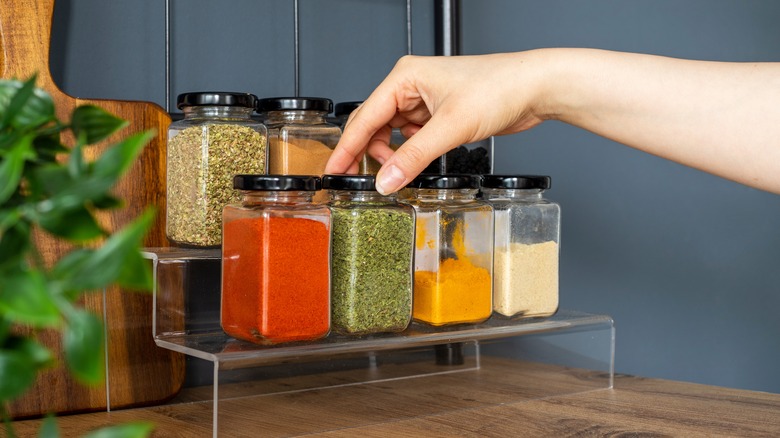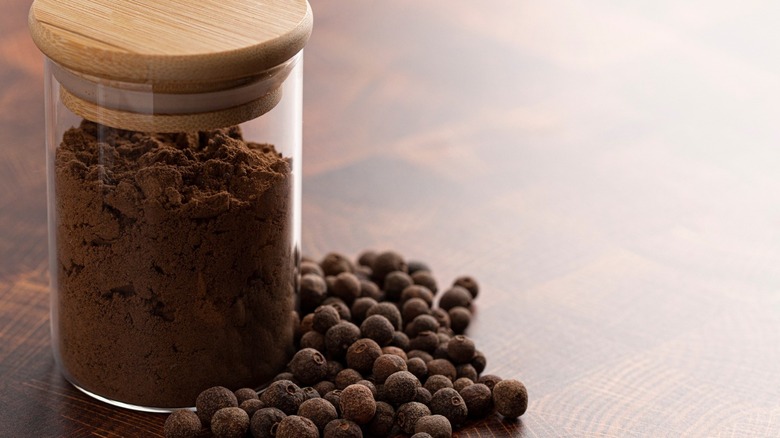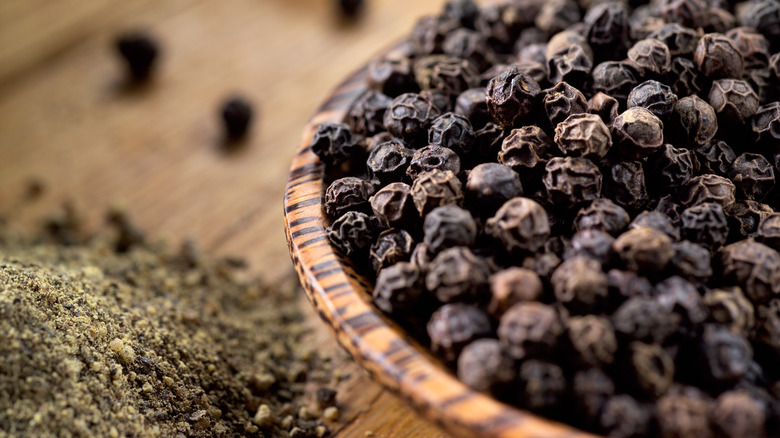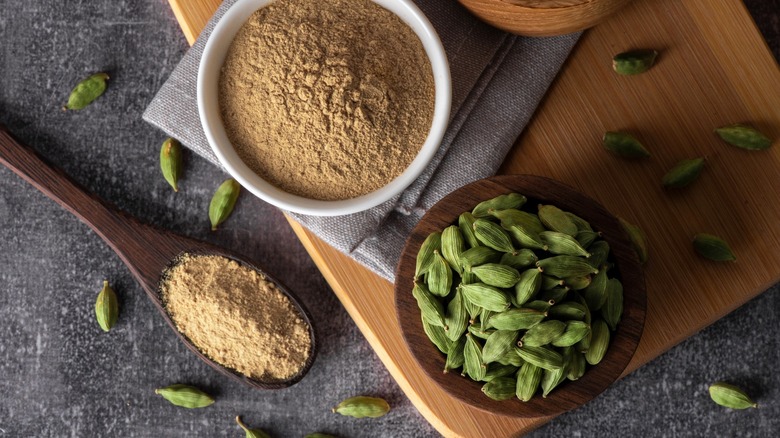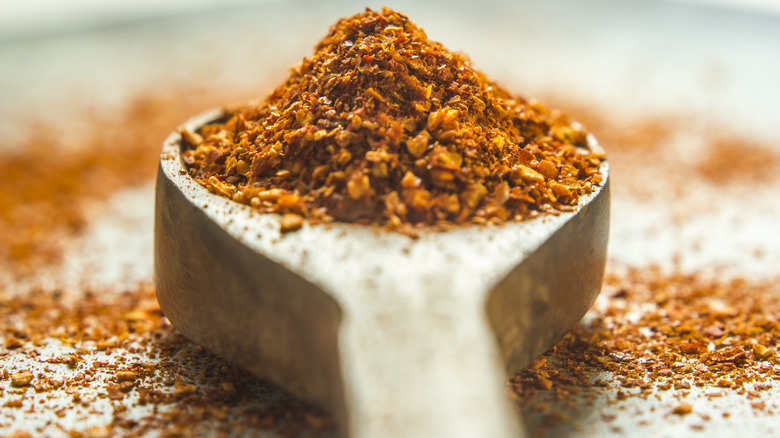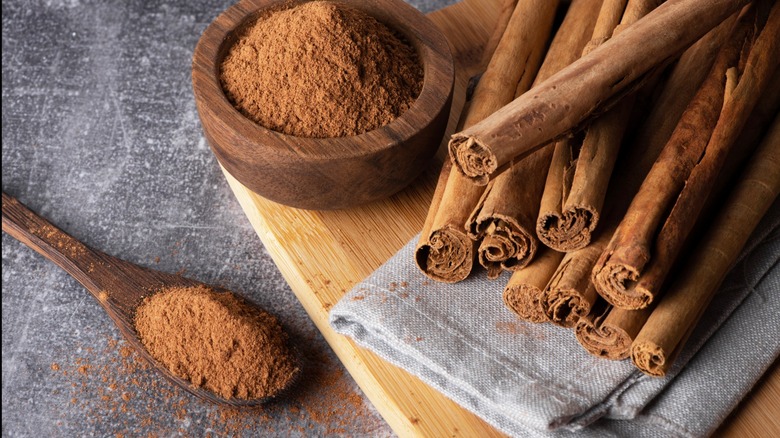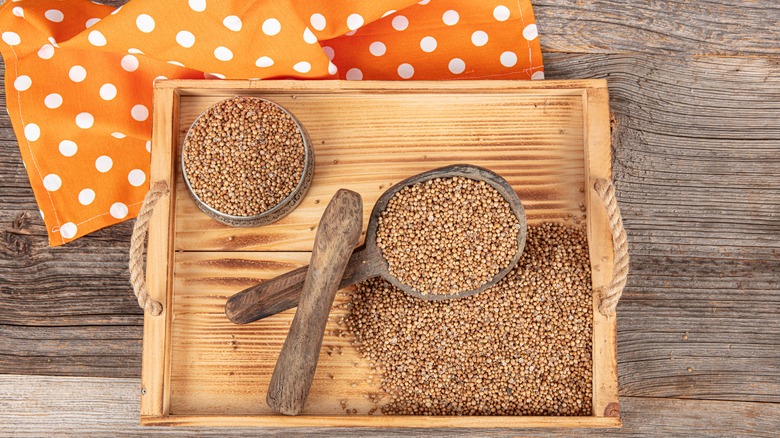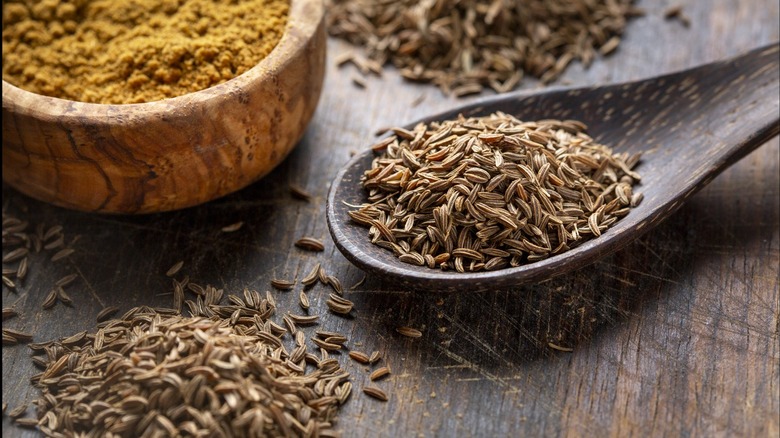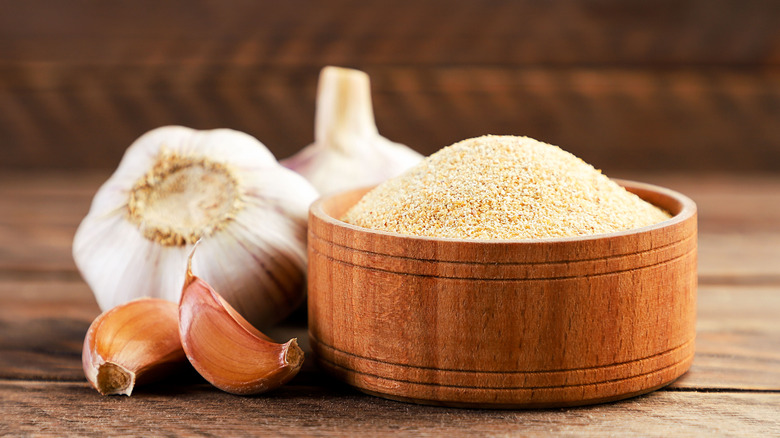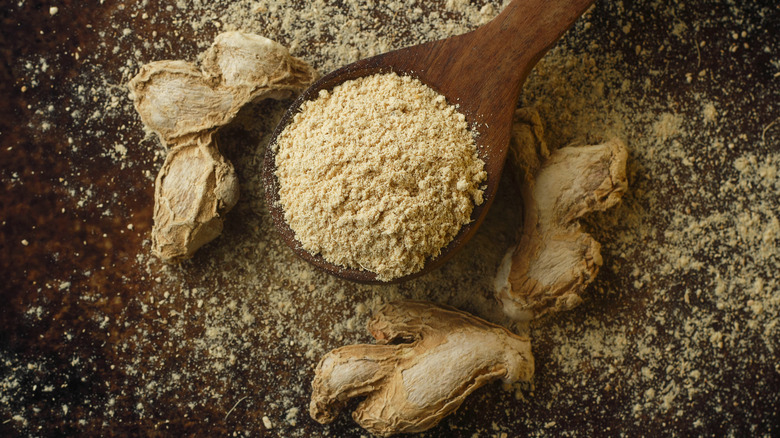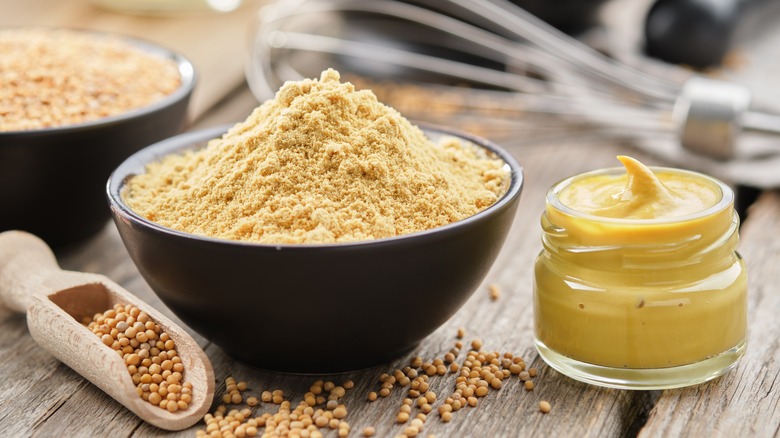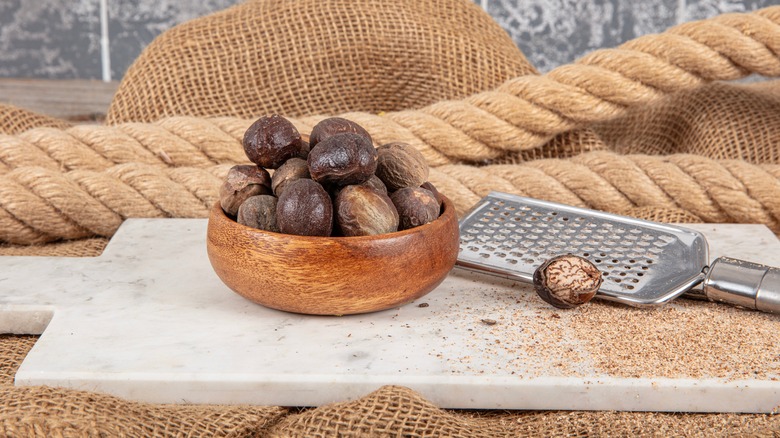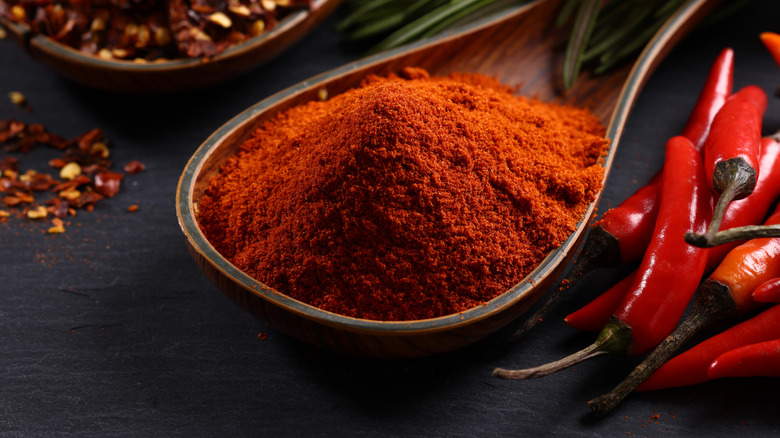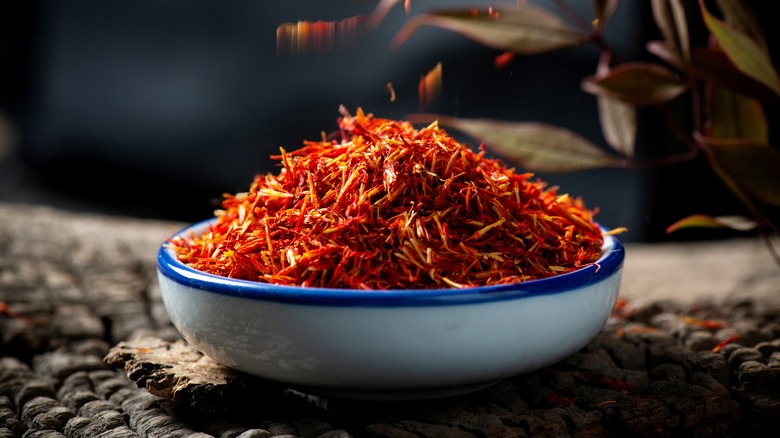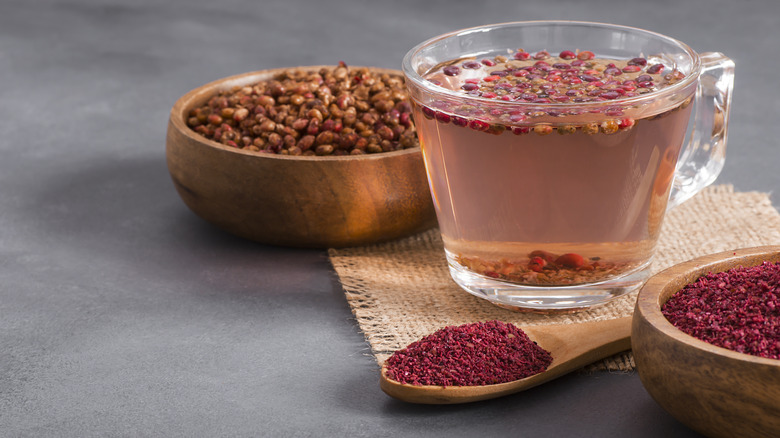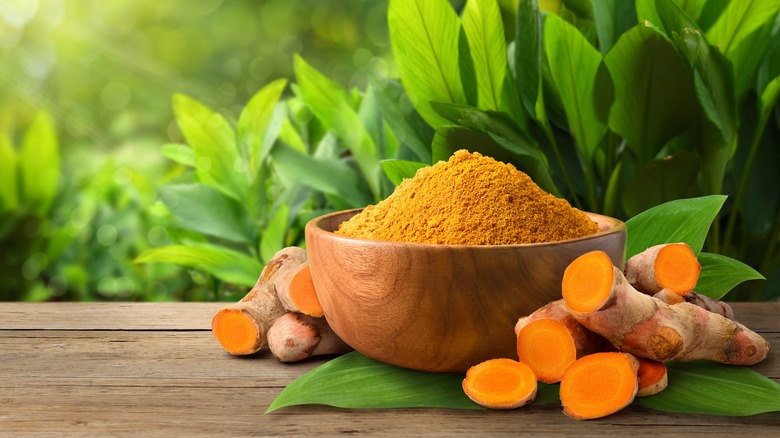How To Store Spices For The Longest Lasting Flavor
There's almost nothing worse than sitting down to a delicious-looking meal only to discover it's completely bland. That's exactly why herbs and spices are vital to cooking and cuisines worldwide.
Humans have been elevating their foods with gifts from Mother Nature for thousands of years. Herbs are the leafy parts of plants; think parsley, basil, and oregano. Spices, meanwhile, are made from other plant parts, like seeds, berries, or bark.
When properly stored, spices can last months, sometimes even years, before they lose their flavor. It all depends on the type of spice and whether it's stored whole or ground and dried. It also depends on where you store the spice. Many people keep spices on a spice rack, but that's not always the best place for them. Keep reading to learn how to get the most out of some popular kitchen spices.
Allspice
Allspice sounds like it should be a blend of spices, but it's not. The spice comes from the dried, unripe berries of the Pimenta dioica, an evergreen tree native to Central America and many Caribbean islands. It's also sometimes called pimento as an homage to its origins. The spice tastes like a combination of cinnamon, cloves, and nutmeg.
Allspice can be purchased as whole berries or already ground into powder. Both types can last up to two years when kept in an airtight container in a cool, dry place out of direct light. However, ground allspice will lose its flavor more quickly than the whole berries. To maximize flavor, store the berries whole or use a spice or coffee grinder, or a mortar and pestle to make your own ground version of the spice
So, how do you use allspice? The whole berries are often used to infuse flavor in sauces or broths, but most recipes call for ground allspice. It's commonly used in dishes from Caribbean, Latin American, and Middle Eastern cuisines. You can also use it in baked goods, dry rubs for steak, and fall favorites like pumpkin pie and apple cider.
Black pepper
Black pepper is a staple of nearly every kitchen; there's a reason salt and pepper shakers are so common! It's also one of the oldest spices, with records showing it's been used since at least 1500 B.C. Black pepper comes from the berries of the Piperaceae plant, a family of flowering vines native to India. The berries are picked, blanched, and dried, creating the familiar black peppercorns in pepper grinders.
Black pepper doesn't expire but can lose flavor after a while. Typically, ground black pepper stays at full flavor for two or three years after it's packaged, but whole peppercorns can stay good for up to four years. The trick is proper storage, as exposure to air can oxidize the pepper and cause it to lose flavor. Keeping it in an airtight container, preferably glass, helps prevent this. You'll also want to keep it away from moisture and heat, which means no storing it above your stove or next to the sink.
Black pepper can be used in nearly any savory dish, from meats to sauces to casseroles to soups. Grinding the pepper fresh with a grinder can help you get the most out of its flavor, and coarsely ground peppercorns will retain more flavor than finely ground ones.
Cardamom
Cardamom is another spice that's been around a while; the Egyptians used it as a mouth freshener, and the Greeks as a perfume. It comes from the pods of plants in the Zingiberaceae, or ginger family. Depending on the plant, the pods may be green or black. Both the pod and the seeds can be used when cooking with cardamom. The taste of cardamom also depends on the type, with the green cardamom having a zesty, citrusy flavor and the black tasting smokey and minty.
You can purchase cardamom as the whole pods or already ground. The ground type is most common in stores, and as a result, most people store cardamom all wrong. Cardamom pods should be stored in an airtight container in a cool, dark place to keep the essential oils inside for maximum, long-lasting flavor. When ready to grind it, use a spice grinder or pestle and mortar.
Most people grind cardamom before cooking with it, although the pods can be used to flavor things like broth. The spice is often used in Middle Eastern, Indian, and other types of Asian cooking and is also commonly used in Scandinavian baked goods. If you're using cardamom for the first time, be careful; a little goes a long way, and too much can quickly overpower a dish.
Chili powder
Chili powder is a spice blend made from mainly cayenne pepper, cumin, and garlic powder. Some may also include spices like paprika and coriander. As a result, it's typically not as hot as pure cayenne pepper but brings more heat than something like basic paprika. It's a great spice to use when you want a bit of a kick.
While you can make chili powder at home, most people buy it pre-blended and ground. To get the most out of your chili powder, it should be stored away from heat, light, and moisture. However, unlike many spices, chili powder does best in the fridge, as the cool temperatures help it to maintain its colors and flavors.
While chili powder is great for spicy dishes, especially in Latin American and Mexican cuisine, that's not the end of its usefulness. This spice blend can be used in meat rubs and marinades, stirred into ground beef, added to stews and sauces, or used to add a little extra heat to a dish.
Cinnamon
Like black pepper, cinnamon is a kitchen staple that's been used for thousands of years. It comes from the bark of Cinnamomum trees, which primarily grow in Asia. There are two primary species of cinnamon that you can purchase in the United States, both are somewhat sweet, but Ceylon cinnamon has a more floral scent, while Cassia cinnamon has a spicier taste.
Cinnamon comes both pre-ground or as sticks. The best storage tip to retain cinnamon's vibrant flavor is to store it in an airtight container in a cool, dry place that's out of direct sunlight. Stored this way, ground cinnamon can last two or three years, while cinnamon sticks can last up to four or five years. You can grind cinnamon sticks using a spice grinder.
Cinnamon sticks are best for infusing flavor into liquids like teas or ciders, whereas ground cinnamon is more commonly used in cooking. Cinnamon is often used in sweet, baked goods, but it's also a key ingredient in many types of cuisines, from Mexican to Indian to Middle Eastern.
Coriander
Coriander is a staple in many spice racks and one of the oldest spices on record, dating back to 5000 B.C. But what is coriander? Coriander is the dried seeds of the Coriandrum sativum plant, the same plant that cilantro comes from. In fact, in the U.S., coriander refers to the dried and crushed seeds, but in Europe, that term is used to describe the cilantro herb. The spice has a taste that's somewhat citrusy, slightly sweet, and subtly nutty.
Coriander can be purchased as whole seeds or as a powder. Both types should be kept in an airtight container in a cool, dry place. The seeds stay fresh for up to four years, whereas ground coriander only retains its flavor for a few months. For best results, you can grind coriander seeds with a spice grinder or food processor.
You can use the whole seeds or the powder to cook with coriander. Whole seeds are great for meat rubs, while powder is best for doughs and batters. The spice can be used in dishes from various cultures, such as Mexican and South American, African, Indian, and Vietnamese cuisines. The flavor deepens the longer it's cooked and pairs excellently with cumin.
Cumin
Cumin is such an ancient spice that it's even mentioned a few times in the Bible. It comes from the seeds of the Cuminum cyminum plant, which is part of the parsley family. The plant can grow in many places, but most of the world's cumin comes from India and the Middle East. If you've never cooked with cumin, you may wonder if it's spicy. While it has some heat, it primarily offers a warm, earthy flavor with sweet and citrusy notes.
You'll find cumin as dried seeds and as a ground, orange-tinged powder. The best way to store cumin is in a cool, dry place within an airtight container. When stored this way, the seeds will last up to four years, although the flavor diminishes around six months. Meanwhile, ground cumin can last up to three years but starts to lose its flavor in around six months. Ground cumin packs more punch, so you can always grind it yourself.
Toast the seeds first before grinding them for optimal flavor. Cumin is used in various dishes and is a common feature in Mexican, Indian, and Middle Eastern cuisines.
Garlic powder
Garlic powder tends to be a polarizing spice, but there's a time and a place for it. Garlic is a vegetable that grows underground in bulbs. It can be used in various ways, and garlic powder is made by peeling, drying, and grinding garlic; plus, it's easy to make garlic powder at home.
One of the benefits of garlic powder is that it lasts longer than fresh garlic. Fresh, peeled garlic lasts a few weeks, while unpeeled garlic can last up to six months. Garlic powder, meanwhile, can last three or four years when properly stored. When garlic powder is exposed to moisture, it can become clumpy, so store it in an airtight container in a cool, dry place.
Many people prefer to cook with fresh garlic rather than garlic powder, but in some cases, the powdered stuff is a better bet. It's great for marinades, spice rubs, and dredges and as a last-minute flavor enhancer. Also, given how easily bulb garlic can burn, the powder version is a great option for food that has to be heated for a long time.
Ginger
Like garlic, ginger is a vegetable that grows underground and becomes a spice once it's dried and ground. Ginger took root over 4,000 years ago in China and has been widely used since then. Ginger is sweet and spicy, making it great in various dishes. It can also be used as an anti-inflammatory and anti-nausea aid.
Most grocery stores carry both fresh and ground ginger. Fresh ginger can last a few weeks in the open or a month or so in the refrigerator. For the longest-lasting freshness, store it in the freezer. Powdered ginger lasts the longest, usually a few years, when properly stored in an airtight container in a cool, dry place.
Fresh ginger has a more complex taste, while dried ginger is spicier, and both have a place in the kitchen. Ginger is a common ingredient in Indian cuisine but can be used in many dishes. It's also great in baked goods, like pumpkin pies and, of course, gingerbread cookies.
Ground mustard
Ground mustard, also called dry or powdered mustard, is made from the seeds of mustard plants. It typically has a sharp and somewhat bitter taste and adds depth to a dish's flavors. While it's an ingredient in the condiment mustard, the two cannot be used interchangeably, as the condiment has many added ingredients.
Both mustard seeds and ground mustard are available to purchase. Both types should be tightly sealed in a cool, dry place for the longest-lasting flavor. Stored like this, mustard seeds will stay good for up to a year, while ground mustard will stay good for up to six months. And, you can grind the seeds into a powder with a food processor or a pestle and mortar.
Ground mustard works well in rubs and marinades for meats, sauces, dips, and casseroles. It's a common spice in many cuisines, especially English, French, and Indian dishes.
Nutmeg
Nutmeg comes from the seeds of the Myristica fragrans tree, a type of evergreen tree native to Indonesia. It's available as dried seeds and as a powder, but the powder is more frequently used. It has a sweet, nutty flavor and pairs well with other warm spices like cinnamon and ginger. It's excellent at accentuating the other flavors of a dish and is incredibly versatile.
Whether you purchase nutmeg as whole seeds or already ground, it should be stored in an airtight container in a cool, dry, dark place. Moisture is especially harmful to nutmeg, so you must keep it far away from places like the sink. Whole seeds taste stronger than ground nutmeg and typically last longer. You can make ground nutmeg using a cheese grater, unlike many other spices.
Nutmeg is excellent in cream-based and béchamel sauces and dark greens, including spinach and kale. A little goes a long way with nutmeg, so use it sparingly. Of course, it is also excellent in cold-weather treats like gingerbread cookies and pumpkin spice lattes.
Paprika
Paprika is another kitchen staple that can be used in various dishes. Here's what you need to know about paprika: It's typically made from several different types of peppers, depending on the variety of paprika. Sweet paprika is the kind normally labeled paprika in the store, and it's got a mild, somewhat sweet taste. Hot paprika is made from spicier peppers, and smoked paprika is made from sweet or spicy peppers that have been smoked before grinding.
Because the varieties of paprika are made from different peppers, you cannot buy the spice whole and grind it yourself. Ground paprika should be kept in an airtight container away from moisture, heat, and direct sunlight. You can keep it in the refrigerator to help it retain its color. Your paprika should stay good for two to three years but may start to lose flavor after a few months.
Like garlic, paprika can burn quickly, so it's best to add it toward the end of your cooking process. Paprika is often a star in Hungarian and Spanish dishes, but it can be used in almost any type of cooking. It's great in cheese sauces, meat rubs, and marinades and pairs well with egg dishes like deviled eggs and eggs benedict.
Saffron
Saffron is one of the rarest and most expensive spices in the world. It comes from the inside of the flower of the Crocus sativus plant, which typically only flowers a few days each year. Threads of saffron are plucked from the flower and then dried. The threads themselves are red, but when added to dishes, saffron adds a golden hue. It typically has an earthy, bitter, sweet, and floral flavor.
When stored properly in an airtight container in a cool, dry, dark place, saffron threads can last up to three years. If you live somewhere hot and humid, consider storing it in the freezer. Powdered saffron should also be kept in a cool, dry place, but it doesn't last nearly as long.
The spice is popular in French, Iberian, Italian, and Middle Eastern dishes, specifically rice dishes, soups, and stews. Because the price can be steep, turmeric is often used as a substitute.
Sumac
Not everyone is familiar with this spice, so what is sumac? It comes from the berries of the Rhus coriaria shrub, which grows all over the world. The berries and the ground powder are a stunning dark red, and the spice has a somewhat bright, sour taste. It can often be used in place of lemon juice.
Both the dried berries and ground powder are available for purchase. For the longest-lasting flavor, they should be stored in an airtight container somewhere away from heat and light. The whole berries can last over a year, while the powder lasts several months.
Unlike many spices, sumac doesn't need to be cooked to release its full flavor. It can be sprinkled on top of vegetables, yogurt, popcorn, and fried foods or mixed into meat rubs, marinades, and sauces. Sumac often enhances the flavor of the foods it's cooked with and blends well with allspice, chili, cumin, and thyme.
Turmeric
Turmeric is a relative of ginger and is a root, just like its spicier cousin. It has an earthy flavor that's often a little sweet and a little peppery. Turmeric can be eaten fresh or dried and ground into a bright orange powder. The difference between fresh and dried turmeric is in the taste; fresh is zingier than the mild dried version. However, most people use dried as it's much easier to use when cooking.
Dried turmeric lasts much longer than fresh turmeric if stored in an airtight container away from moisture and direct light. Fresh turmeric can last in a fridge for about two weeks, but it takes some effort to keep it dry. You can also freeze it for up to six months.
Turmeric can be a great addition to a variety of foods, such as rubs, marinades, soups, stews, curries, and other dishes. It pairs well with spices like cinnamon, cumin, ginger, and paprika. But be careful — turmeric can leave an orange stain on your dishes or fingers.
